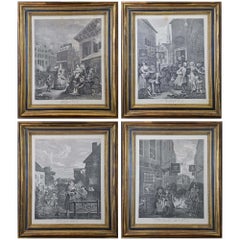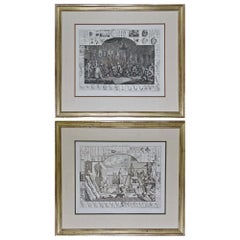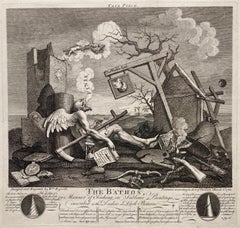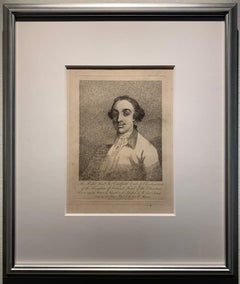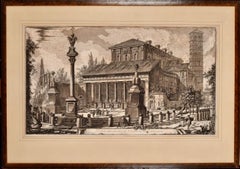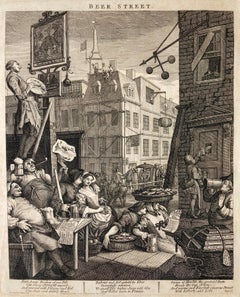William Hogarth Art
British, 1697-1764
William Hogarth (1697-1764) was an English painter, printmaker, pictorial satirist, social critic, and editorial cartoonist. Hogarth's work was extremely diverse, ranging from serious realistic paintings and portraits to satire and moralistic pieces filled with symbolism. He often communicated his moral message in a series of paintings and engravings, such as: A Rake's Progress, Marriage A-la-Mode and A Harlot's Progress. He was by far the most significant English artist of his generation and inspired a movement of English caricaturists and satirists, including James Gillray (1756-1815), Thomas Rowlandson (1757-1827), Isaac Cruickshank (1764-1811) and George Cruickshank (1792-1878). His work has been studied intensely for the greater than two and a half centuries since his death with several academic scholars focusing their careers on the analysis of every element of each of his creations.to
3
3
2
4
Overall Width
to
Overall Height
to
6
3
6
4
6
3
7
5
5
4
1
1
1
1
1
1
5
4
1
1
1
12
8,228
2,805
1,654
1,315
4
1
7
2
Artist: William Hogarth
Four Framed Hogarth Engravings "Four Times of the Day"
By William Hogarth
Located in Alamo, CA
The four plates in this "Four Times of the Day" set were created utilizing both engraving and etching techniques by William Hogarth in 1738. Hogarth's original copper plates were refurbished where needed by James Heath and these engravings were republished in London in 1822 by Braddock, Cradock & Joy. This was the last time Hogarth's original copper plates were used for printing. Most were melted down during World War I for the construction of bombs. Printed upon early nineteenth century wove paper and with large, full margins as published by William Heath in 1822. The inscription below each print reads "Invented Painted & Engraved by Wm. Hogarth & Publish'd March 25. 1738 according to Act of Parliament".
These large folio sized "Four Times of the Day" engravings/etchings are presented in complex gold-colored wood frames with black bands and scalloped gold inner trim. A majority of each thick impressive frame is covered with glass applied near the outer edge. Each frame measures 25.75" high, 22.25" wide and 1.88" deep. There are a few small dents in the edge of these frames, which are otherwise in very good condition. "Morning" has two focal areas of discoloration in the upper margin and some discoloration in the right margin, a short tear in the left margin and a short tear or crease in the right margin. "Noon" has a spot in the upper margin that extends into the upper image, but it is otherwise in very good condition. "Evening" has a faint spot in the upper margin, but it is otherwise in very good condition. "Night" is in excellent condition.
The "Four Times of the Day" series is in the collection of many major museums, including: The British Museum, The Metropolitan Museum of Art, The Tate Museum, The Chicago Art Institute and The Victoria and Albert Museum.
Through this series Hogarth is portraying early 18th century London street life at "Four Times of the Day". His characters are exhibiting their personalities, quircks, strange activities, but he also wants to draw attention the disparities between the wealthy aristocracy and the common working class.
Plate 1, "Morning" depicts morning in Covent Garden in the winter in front of Tom King...
Category
Mid-18th Century Old Masters William Hogarth Art
Materials
Engraving, Etching
William Hogarth's "Analysis of Beauty": A Set of Two Framed 18th C. Engravings
By William Hogarth
Located in Alamo, CA
The two plates in this set were created utilizing both engraving and etching techniques by William Hogarth in 1753, originally as illustrations of his book on aesthetics, entitled "Analysis of Beauty". Due to their popularity, these plates were later published separately. The publication line in the lower right reads: "Designed, Engraved, and Publish'd by Wm. Hogarth, March 5th 1753, according to Act of Parliament." Hogarth's original copper plates were refurbished where needed by James Heath and engravings were republished in London in 1822 by Braddock, Cradock & Joy. This was the last time Hogarth's copper plates were used for printing. Most were melted during World War I for the construction of bombs.
These large folio sized "Analysis of Beauty" engravings are presented in antiqued gold-colored frames with double mats; the outer silk mats are light brown-colored and the inner mats are dark brown. Each frame measures 27.38" x 31.25" x 1.13". There is one tiny spot in the right margin of plate 1 and another in the lower margin; the latter could be from the printing process. The prints are otherwise in excellent condition.
The "Analysis of Beauty" series is in the collection of many major museums, including: The British Museum, The Metropolitan Museum of Art, The Tate Museum, The Chicago Art Institute and The Fine Arts Museums of San Francisco.
The first engraving (Plate 1) depicts a courtyard of statues which is filled with some of the most famous works of classical sculpture. The most important sculptures are surrounded by less impressive works. The Medicean Venus (#13) is in the center with a statue of Julius Caesar (#19) to the right, elevated on a pulley with a short, overdressed Brutus stands over the falling Caesar. The Apollo Belvedere (#12) is next. A judge stands to the right with his foot on a cherub (#16). Another crying cherub holds a gallows and wipes his tears with the judge's robe.
A sphinx (#21) and the drunken Silenus (#107) are below the Venus. Michaelangelo's torso (#54) and a statue of Antonius (#6) are seen in the foreground. The Farnese Hercules (#3) and a bust of another Hercules (#4) under two statuettes of Isis are also included in the scene.
The key to these objects is included in the form of a serpentine line winding around a cone (#26), Hogarth's "Line of Beauty". For Hogarth the winding line is an essential element of beauty in art. Hogarth's theory of beauty is communicated in this plate.
Plate 2 is thought to represent the Wanstead Assembly, with the Earl of Tynley and his household. It is an adaptation of a scene in the Happy Marriage series, which complements Hogarth's Marriage à la Mode...
Category
Mid-18th Century Old Masters William Hogarth Art
Materials
Engraving, Etching
BATHOS / Tail PIece
By William Hogarth
Located in Santa Monica, CA
WILLIAM HOGRATH (1767- 1764)
THE BATHOS / Tail Piece 1764 (Paulson 1989: 216 I/I Paulson 1965/70: 216 I/I)
Engraving Plate 12 7/8 x 13 3/8, sheet 17 ¾ x 18 ¾ Designed & Engrav’d by Wm Hogarth at left and Published according to Act of Parliam’t March 3, 1764 at right. Good condition on thick laid paper Small bit of tape on the left & right sheet edges small stan lower sheet edge all on recto.
This Hogarth’s last print is fascinating as it is prophacy about death.
Various institutions have interesting commentaries - to wit:
Chicago Art Institute: Hogarth created The Bathos toward the end of his life. It is considered one of the bleakest artworks of the 18th century because it depicts the Apocalypse without an afterlife. The Angel of Death even collapses in exhaustion after having destroyed the world. In his hand is an execution decree and around him lies a mass of broken objects.
Princeton: Hogarth’s last print, The Bathos,….. is filled with all manner of images denoting the end of life as we know it. Entry no. 216 in Ronald Paulson’s catalogue raisonne Hogarth’s Graphic Works, 3rd revised edition says “This print is the culmination of such pessimistic images . . . . [taking] his general composition, the configuration of objects, and some of the particular items, from Dürer’s engraving, Melancholia; but he also recalls Salvator Rosa’s Democritus in Meditation (which derives from Dürer’s print) with a scroll at the bottom of the etching: ‘Democritus the mocker of all things, confounded by the ending of All Things’ (Antal, p.168).”
Newfields (Indianapolis Museum of Art): Hogarth intended this engraving to serve as the tailpiece to bound volumes of his collected engravings and, appropriately, it proved to be his last engraving. Father Time has died and his last will and testament has been witnessed by the three Fates. He is surrounded by a landscape of death, decay, and ruin. Hogarth aimed this print at dealers in “dark” Old Masters paintings who promoted the idea that ruins evoked sublime feelings in viewers—a sentiment, Hogarth wrote, that was reducing the world to ruin.
British Caricature...
Category
1760s Old Masters William Hogarth Art
Materials
Woodcut
'Portrait of James Caulfield' by William Hogarth, Etching
By William Hogarth
Located in Oklahoma City, OK
This 21" x 18" etching was produced by William Hogarth in the mid-18th century. The work has been newly matted and framed with archival materials. The subject, identified as James Caulfield, 4th Viscount, 1st Earl of Charlemont (1728-1799), became commander in chief of the Irish Volunteers...
Category
1780s Realist William Hogarth Art
Materials
Etching
"A Harlot's Progress" Plate 3 Etching
By William Hogarth
Located in Houston, TX
Etching from the series titled "A Harlots Progress" by William Hogarth. The series consists of six paintings and engravings. The story is about a woman named M. Hackabout who arrived in London and started working as a prostitute. The third plate is of her getting arrest for her choice in profession. The series is a satirical story that emphasizes the dangers of being a prostitute and the health risks that come from it.
In 18th century engraving, the detail of the black mole on women and men's face is a symbol of the deadly venereal disease, syphilis. In this plate, Hackabout has already contracted the disease and that is why the black dot is visible on her forehead as well as her madam's.
In 1828, William Innell Clement published Harlot's Progress in columns on a single page of his newspaper Bell's Life in London #330. The detail with the cross seen in earlier reproductions of the engraving.
Dimensions without Frame: H 14.5 in x W 16.5 in.
Artist Biography: William Hogarth ( 10 November 1697 – 26 October 1764) was an English painter, printmaker, pictorial satirist, social critic, and editorial cartoonist. His work ranged from realistic portraiture to comic strip-like series of pictures called "modern moral subjects", perhaps best known to be his moral series A Harlot's Progress, A Rake's Progress and Marriage A...
Category
1730s Old Masters William Hogarth Art
Materials
Etching
William Hogarth . Original engravings 155 pсs., 1 piece with blend. 1822 London
By William Hogarth
Located in Riga, LV
William Hogarth (1697-1764)
Original engravings 155 pсs., 1 piece with blend. 1822 London
From A. Neibergs collection
Category
1820s Realist William Hogarth Art
Materials
Paper, Engraving
The Company of Undertakers, Original period engraving
By William Hogarth
Located in Spokane, WA
Measurements
Engravings 10.5 x 7 inches sight
Framed 14.875 x 11.5 inches
The Company of Undertakers (1737) is a satirical print by William Hogarth that mocks the medical professi...
Category
1730s William Hogarth Art
Materials
Engraving
$2,800 Sale Price
20% Off
"The Beggars Opera" and " A Just View of The British Stage" Original Etchings
By William Hogarth
Located in Houston, TX
The original design for the top half was formally attributed to William Hogarth, according to the Met Museum, and published by John Bowles in 1728. The edition here has a second half...
Category
1820s Baroque William Hogarth Art
Materials
Etching
Character - Original Drawing - 19th Century
By William Hogarth
Located in Roma, IT
Character is an original drawing in China ink and watercolor, realized by an anonymous artist of the 19th century, applied on greenish paper.
The state of preservation is good.
The...
Category
19th Century William Hogarth Art
Materials
Watercolor, Ink
$586 Sale Price
25% Off
Related Items
Basilica of San Lorenzo in Rome: A Framed 18th Century Etching by Piranesi
By Giovanni Battista Piranesi
Located in Alamo, CA
This large framed 18th century etching by Giovanni Battista Piranesi entitled "Veduta della Basilica di S. Lorenzo fuor della mura" (Basilica of San Lorenzo Outside the Walls), published in Rome in 1750 in Piranesi's Vedute di Roma (Views of Rome), This etching depicts the Basilica of San Lorenzo Outside the Walls, which is a Roman Catholic papal basilica and parish church, located in Rome, Italy. The Basilica is one of the Seven Pilgrim Churches of Rome and one of the five "papal basilicas". It was built as a shrine to the martyred Roman deacon St. Lawrence.
This Piranesi etching is held by many museums and institutions, including: The Metropolitan Museum, The British Museum, The National Gallery of Art, The Yale University Art Gallery, and The Harvard Museum of Art.
This magnificent etching is presented in a brown-colored wood frame and a tan French...
Category
1750s Old Masters William Hogarth Art
Materials
Etching
$2,975
H 23.13 in W 33 in D 0.5 in
Self Portrait With Children - Original woodcut (Buisson #60.109)
By Léonard Tsuguharu Foujita
Located in Paris, IDF
Leonard Tsuguharu FOUJITA
Self Portrait With Children, 1960
Original woodcut
On vellum 37 x 28 cm (c. 15 x 11 in)
REFERENCES : Catalogue Raisonne Sylvie Buisson #60.109
Excellent ...
Category
1960s Realist William Hogarth Art
Materials
Etching
$901
H 14.57 in W 11.03 in
Thoughtful Woman - Etching from Louvre Museum
By Louis Valtat
Located in Paris, IDF
Louis VALTAT
Thoughtful Woman
Etching
Signed with the artist's monogram in the plate
On vellum 38 x 28.5 cm (c. 14.97 x 11.23 inch)
INFORMATION : Published by the Chalcographie du ...
Category
Mid-20th Century Realist William Hogarth Art
Materials
Etching
Carte Particuliere Des Coste De Bretagne qui Comprend Morlaix
By Pierre Mortier
Located in Paonia, CO
Carte Particuliere Des Costes De Bretagne qui Comprend Morlaix, Saint Paul de Leon, les Sept Isles, et L’Isle. Faite par ordre Exprez Du Roy de France is from the collection of ch...
Category
1690s William Hogarth Art
Materials
Engraving
$1,350
H 25 in W 37.5 in
Crucifixion
Located in Fairlawn, OH
Jean Pichore workshop, 1500-1541
Crucifixion
Metal cut engraving printed on vellum with vintage hand coloring
c. 1500-1541
Miniature (image) size: 4 3/4 x 3 1/8"
Including decorated ...
Category
16th Century Old Masters William Hogarth Art
Materials
Engraving
Church of St. Costanza, Rome: An 18th Century Piranesi Architectural Etching
By Giovanni Battista Piranesi
Located in Alamo, CA
This is a framed 18th century Giovanni Battista Piranesi etching entitled: "Veduta interna del Sepocro di Santa Costanza, fabbricat...
Category
1770s Old Masters William Hogarth Art
Materials
Etching
$3,775
H 27 in W 32 in D 1.5 in
The Basilica of St. Paul in Rome, Early 19th Century Etching by Luigi Rossini
By Luigi Rossini
Located in Alamo, CA
"Rovina della gran Basilica di S. Paolo fueri le mura accaduta" (View of the Ruins of the Great Triumphal Arch of S. Paolo Fuori le Mura) from "Le Antichita Romane" (Ancient Rome), published in Rome in 1823. It depicts the destruction of the Basilica of St. Paul after the fire of 1823. People stand in the road and on the right observing the damage amid debris, which includes many fragments of columns.
The etching is presented in a silver-color wood frame with an off-white double mat with a black inner mat. There are a few small spots, but it is otherwise in very good condition. See item # LU117324669722 for another Rossini etching...
Category
1820s Old Masters William Hogarth Art
Materials
Etching
$3,275
H 27.5 in W 37.13 in D 0.88 in
Fabricius (Ponte Cestio) Bridge : Framed 18th C. Piranesi Architectural Etching
By Giovanni Battista Piranesi
Located in Alamo, CA
This framed 18th century etching by Giovanni Battista Piranesi is entitled "Dimostransi nella Tav. presente la Pianta, ed Elevazione del Ponte, oggi detto Quattro Capi egli è antichissimo, e chiamavasi Fabrizio da L. Fabrizio Presid. delle Strade, che lo fabbrico' nel fine della Repubblica. "(The Plan and Elevation of the Bridge, today called Quattro Capi. The architect is very ancient, and was called Fabrizio da L. Fabrizio Presid. delle Strade, who built it at the end of the Republic). This is plate 18 in volume 4 of Piranesi's "Le antichita romane opera di Giambatista Piranesi architetto veneziano" (Roman antiquities by Giambatista Piranesi Venetian architect). It was published in Rome in 1756-1757.
This etching depicts the plan and elevation of the bridge now called the Ponte dei Quattoro Capi or Ponte Cestio (Bridge of the Four Heads), which in antiquity was called the Bridge of Fabricius after L. Fabricius, the Superintendant of the Streets who built it at the end of the Republic, around 62 BC. It was also been known in the Middle Ages as ‘Ponte Giudeo’ (Bridge of the Jews). The bridge crossed from the left bank or northeast side of the Tiber River to Tiber Island...
Category
1750s Old Masters William Hogarth Art
Materials
Etching
$1,375
H 25.63 in W 30.5 in D 0.36 in
Lafitte's Blacksmith House (a bar named for a pirate on Bourbon St, New Orleans)
By Frederick Mershimer
Located in New Orleans, LA
Lafitte's Blacksmith Shop is a New Orleans landmark at 941 Bourbon St. Like most New Orleans legends, history of Lafitte's Blacksmith Shop is a gumbo of tru...
Category
Early 2000s Contemporary William Hogarth Art
Materials
Mezzotint, Aquatint
Crucifixion: 18th Century Etching by Conrad Metz after Daniele da Volterra
Located in Alamo, CA
"Crucifixion" is an etching and aquatint, printed in brown ink by Conrad M. Metz after a painting by Daniele da Volterra. It was published in London in 1789 in 'Imitations Of Ancient...
Category
Late 18th Century Old Masters William Hogarth Art
Materials
Etching, Aquatint
$975
H 17 in W 11.75 in
The Smell of Us (Hand signed poster)
By Larry Clark
Located in New York, NY
Larry Clark
The Smell of Us (Hand signed poster), 2015
Offset lithograph poster
Pencil signed by Larry Clark on the back
10 1/2 × 15 1/2 inches
Unframed
Limited edition poster; hand ...
Category
2010s Realist William Hogarth Art
Materials
Lithograph, Offset
Woolworth Building, New York
By Paul Schumann
Located in Middletown, NY
A rich and tonal image of an icon of Manhattan architecture.
Etching with drypoint, 11 7/8 x 7 3/8 inches (300 x 186 mm), full margins. Edition of 100. Signed in pencil, lower right...
Category
Early 20th Century Realist William Hogarth Art
Materials
Handmade Paper, Drypoint, Etching
Previously Available Items
BEER STREET
By William Hogarth
Located in Santa Monica, CA
WILLIAM HOGARTH (BRITISH 1675 – 1764)
BEER STREET 1751(Paulson 185 iii/iii)
Etching and engraving Design’d by W, Hogarth lower left, Publish’d according to act of Parliament...
Category
1750s Old Masters William Hogarth Art
Materials
Engraving, Etching
Mr. Garrick in the Character of Richard the 3rd - FINE IMPRESSION
By William Hogarth
Located in Santa Monica, CA
WILLIAM HOGRTH (1697 - 1764)
MR. GARRICK IN THE CHARACTER OF RICHARD THE 3RD (Shakespear Act 5 Scene 7)
(Paulson 1970.165 ii/ii; Paulson 1989.165 ii/ii;, Dobson and Armstrong p. 20...
Category
1740s Old Masters William Hogarth Art
Materials
Engraving, Etching
"Principal Inhabitants of the Moon": A Framed 18th Century Satire by Hogarth
By William Hogarth
Located in Alamo, CA
This is a framed original satirical etching/engraving by William Hogarth, entitled "Some Principal Inhabitants of ye Moon: Royalty, Episcopacy and Law", originally published in London in 1760.The inscription reads: ""Some of the principal inhabitants of [the] moon as they were perfectly discover'd by a telescope brought to [the] greatest perfection since [the] last eclipse; exactly engraved from the objects whereby [the] curious may guess at their religion, manners, &c.". Although this may be an original life-time printing, it may have been published by Baldwin Craddock and Joy in London in 1822 from Hogarth's original copper plate that was reworked where needed by Heath, referred to as the Heath edition. This publication was the last time that Hogarth's plates were used for a printing. Most were subsequently destroyed and those remaining are primarily held by institutions.
The scene is presented within a circle, as if seen through a telescope viewing the moon, surrounded by a square border, under which is engraved the title. The figures, who are satirically supposed to be the inhabitants of the moon, sit on a wooden platform suspended above the clouds. Three seated figures are supposed to represent the "Monarchy, Episcopacy, and Law". "Monarchy", representing royalty, sits on a throne wears a crown and he holds a globe and a sceptre. His face is a gold coin. The symbol of perpetuity, is embroidered on the cloth under his throne.
"Episcopacy", representing the church, is operating a pump by pulling on a bell-rope fastened around a bible attached to the pump handle. The pump pours out money into a chest representing the church coffers and wealth. The chest is decorated with an armorial escutcheon, containing a knife and fork, topped by a church leader's mitre. Episcopacy's face is a Jew’s Harp and his right foot rests on a pile of three cushions. A cloven foot is seen protruding from under his religious robe.
"Law" wears the type of wig worn by 18th century English judges. He holds a large sword on the right, but he does not appear to have a left arm. His face is a hammer resembling that of the Viking god Thor. Behind him a dagger appears to be thrust through the bottom of a sieve.
The bodies of the attendants on Monarchy are composed of circular fire-screens, resembling shields. The trunks of the Courtiers are large looking-glasses, the sconces, with candles in them serving for hands and arms. The face of the chief of these is the reverse of a sixpence; and a key significantly appended to his sash at once denotes his sex and office. Under the figure of Law are a male and female modishly dressed. Her head is a tea-pot, her neck is a drinking-glass and her body is a half open fan. The male figure's face is a coat of arms and his legs are fan sticks. He appears to be courting the female.
There is a great deal of satirical symbolism in this print and their meaning is not always obvious. Hogarth may have planned to include an explanation since there are letters a, b, c, d, e, f and g placed over or under some of the figures and objects. The reference books by Ronald Paulson, such as "Hogarth's Graphic Works, provide some possible interpretations.
The print is presented in an ornate glossy black wood frame with beaded gold-colored outer and inner trim, a beaded gold-colored fillet and a cream-colored silk mat. There is a small defect in the frame's right upper edge. The print was not examined out of the frame, but the visible portions of the print are in excellent condition. The frame and mat style are identical to another old master print listed on 1stdibs, a 17th century portrait of the old master artist Petrus de Jode by Anthony van Dyck. This print can be viewed by placing the 1stdibs reference # LU117327129592 in the search field. These two framed prints would make a striking display grouping. A discount is available for purchase of the pair.
Artist: William Hogarth (1697-1764) was an English painter, printmaker, pictorial satirist, social critic, and editorial cartoonist. Hogarth's work was extremely diverse, ranging from serious realistic paintings and portraits to satire and moralistic pieces filled with symbolism. He often communicated his moral message in a series of paintings and engravings, such as: A Rake's Progress, Marriage A...
Category
Mid-18th Century Old Masters William Hogarth Art
Materials
Engraving, Etching
H 22 in W 19 in D 1.13 in
"The Enraged Musicians" Original Baroque Etching
By William Hogarth
Located in Houston, TX
The print was published as a companion to the ‘Distressed Poet’, the original of which is in the City Museum and Art Gallery, Birmingham. When advertising its publication in the pres...
Category
1820s Baroque William Hogarth Art
Materials
Etching
"The Beggar's Opera Act III" Original Barque Etching
By William Hogarth
Located in Houston, TX
William Hogarth's illustration of John Gay's "The Begger's Opera". In this plate, the character of Macheath stands in the center shackled. On either side of him is his lover and wife...
Category
1820s Baroque William Hogarth Art
Materials
Etching
William Hogarth (1697–1764) - 1746 Engraving, Mr Garrick, Richard the Third
By William Hogarth
Located in Corsham, GB
A very fine 18th century copper plate engraving from William Hogarth and Charles Grignion (1721–1810). Hogarth depicts his close friend, the actor David Garrick, as Richard III wakin...
Category
18th Century William Hogarth Art
Materials
Engraving
An Election Entertainment - Original Etching by William Hogarth - 1755
By William Hogarth
Located in Roma, IT
An Election Entertainment is an original etching realized by William Hogarth in 1755. The etching was engraved also by Francois Morellon de la Cave.
Original title: An Election Entertainment, Plate I: Four Prints of an Election.
Signature on plate: "Painted and the Whole Engraved by Wm. Hogarth. / Published 24th Febry. 1755, as the Act directs".
Inscription on plate: "To the Right Honourable Henry Fox, &c. &c. &c. This plate is humbly Inscrib'd by his most Obedient Humble Servt. Wm. Hogarth".
Includes passepartout and frame (62 x 2 x 74 cm).
Good conditions, except for a browning of paper due to the signs of aging.
The print is from the series The Humours of an Election (1754-58), the artist's last painted cycle regarding contemporary affairs. The paintings are now in Sir John Soane's Museum, London.
Unlike the other three engravings in the series, An Election Entertainment does not reverse the original painting, as in the case of when Hogarth made engravings...
Category
1750s Old Masters William Hogarth Art
Materials
Etching
H 16.93 in W 22.05 in D 0.04 in
The Polling - Original Etching by William Hogarth - 1758
By William Hogarth
Located in Roma, IT
The Polling is an original etching realized by William Hogarth in 1758. The etching was engraved also by Francois Morellon de la Cave.
Original title: The Polling, Plate III: Four Prints of an Election.
Signature on plate: "Engrav'd by W. Hogarth & Le Cave...
Category
1750s William Hogarth Art
Materials
Etching
H 16.93 in W 22.05 in D 0.04 in
The Works Of William Hogarth From The Original Plates - 1820s - Old Master
By William Hogarth
Located in Roma, IT
Big In-folio Volume
Baldwin and Cradock, London
Majestic work collection most of Hogarth’s graphic production, printed from the original plates. Restored by James Heath.
The Volume ...
Category
1820s Old Masters William Hogarth Art
Materials
Paper
H 25.4 in W 19.3 in D 0.6 in
The Sleeping Congregation.
By William Hogarth
Located in Storrs, CT
1736 (Heath Edition 1822). Etching and engraving. Paulson 140 iv/iv; British Museum Satires 2285. 10 1/2 x 8 3/16 (sheet: 12 7/8 x 9 3/4). Inscription: in plate below image, lower le...
Category
1730s Old Masters William Hogarth Art
Materials
Engraving, Etching
William Hogarth art for sale on 1stDibs.
Find a wide variety of authentic William Hogarth available for sale on 1stDibs. You can also browse by medium to find art by William Hogarth in etching, engraving, ink and more. Much of the original work by this artist or collective was created during the 18th century and is mostly associated with the Old Masters style. Not every interior allows for large William Hogarth, so small editions measuring 5 inches across are available. Customers who are interested in this artist might also find the work of Samuel & Nathaniel Buck, Giovanni Battista Tiepolo, and John Thomas Smith. William Hogarth prices can differ depending upon medium, time period and other attributes. On 1stDibs, the price for these items starts at $350 and tops out at $5,420, while the average work can sell for $737.
